IFRS Conceptual Framework: A Detailed Analysis of Reporting Standards
VerifiedAdded on 2023/06/04
|11
|2596
|267
Report
AI Summary
This report delves into the conceptual framework of financial reporting as developed by the International Accounting Standards Board (IASB), emphasizing its purpose, objectives, and recent revisions. The primary aim of the framework is to aid in the development of International Financial Reporting Standards, promoting uniformity in accounting practices globally. The 2018 revision addresses shortcomings of the 2010 framework, particularly regarding measurement provisions, stewardship, and prudence. The report discusses the role of the framework in guiding accounting standard formulation, addressing unusual transactions, and providing a common base for standard setters. It highlights the reasons for revisions, including the lack of measurement guidance, presentation and disclosure considerations, new definitions of assets and liabilities, and the reintroduction of stewardship and prudence concepts. Furthermore, the report examines improvements such as factors for selecting appropriate measurement bases, guidance on income and expense classification, and the introduction of the de-recognition principle, concluding that the conceptual framework is vital for maintaining integrity in the accounting profession.
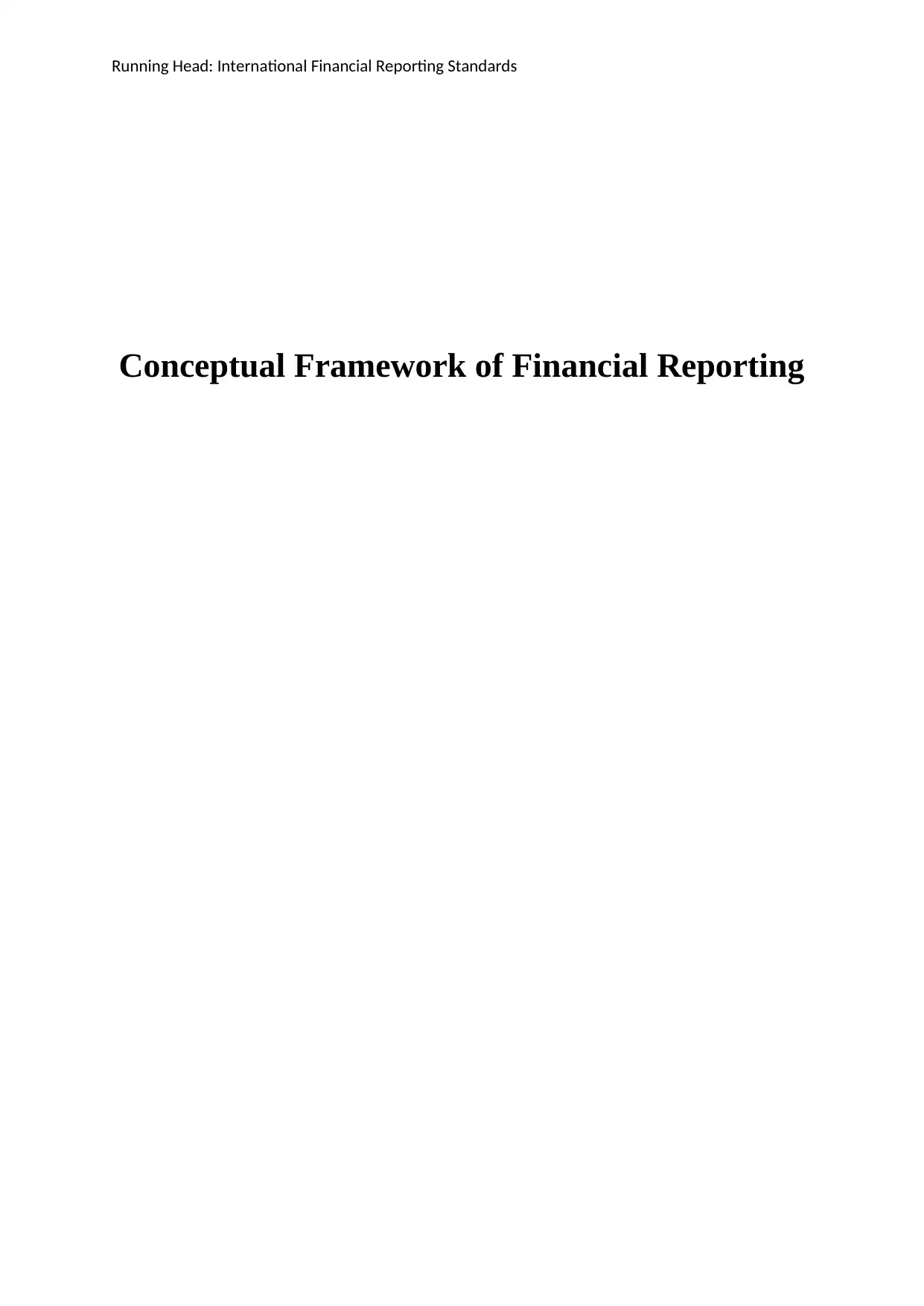
Running Head: International Financial Reporting Standards
Conceptual Framework of Financial Reporting
Conceptual Framework of Financial Reporting
Paraphrase This Document
Need a fresh take? Get an instant paraphrase of this document with our AI Paraphraser
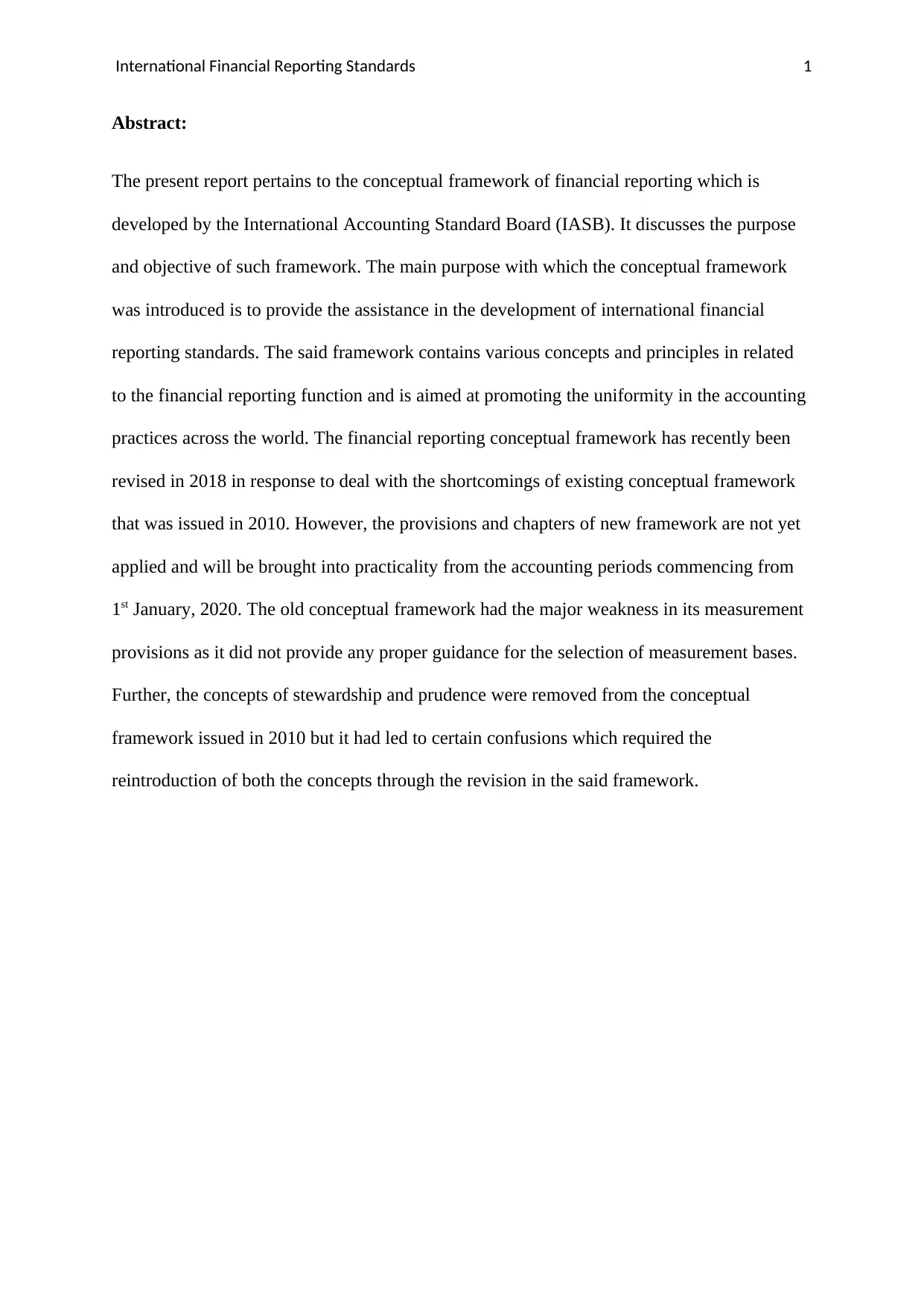
International Financial Reporting Standards 1
Abstract:
The present report pertains to the conceptual framework of financial reporting which is
developed by the International Accounting Standard Board (IASB). It discusses the purpose
and objective of such framework. The main purpose with which the conceptual framework
was introduced is to provide the assistance in the development of international financial
reporting standards. The said framework contains various concepts and principles in related
to the financial reporting function and is aimed at promoting the uniformity in the accounting
practices across the world. The financial reporting conceptual framework has recently been
revised in 2018 in response to deal with the shortcomings of existing conceptual framework
that was issued in 2010. However, the provisions and chapters of new framework are not yet
applied and will be brought into practicality from the accounting periods commencing from
1st January, 2020. The old conceptual framework had the major weakness in its measurement
provisions as it did not provide any proper guidance for the selection of measurement bases.
Further, the concepts of stewardship and prudence were removed from the conceptual
framework issued in 2010 but it had led to certain confusions which required the
reintroduction of both the concepts through the revision in the said framework.
Abstract:
The present report pertains to the conceptual framework of financial reporting which is
developed by the International Accounting Standard Board (IASB). It discusses the purpose
and objective of such framework. The main purpose with which the conceptual framework
was introduced is to provide the assistance in the development of international financial
reporting standards. The said framework contains various concepts and principles in related
to the financial reporting function and is aimed at promoting the uniformity in the accounting
practices across the world. The financial reporting conceptual framework has recently been
revised in 2018 in response to deal with the shortcomings of existing conceptual framework
that was issued in 2010. However, the provisions and chapters of new framework are not yet
applied and will be brought into practicality from the accounting periods commencing from
1st January, 2020. The old conceptual framework had the major weakness in its measurement
provisions as it did not provide any proper guidance for the selection of measurement bases.
Further, the concepts of stewardship and prudence were removed from the conceptual
framework issued in 2010 but it had led to certain confusions which required the
reintroduction of both the concepts through the revision in the said framework.
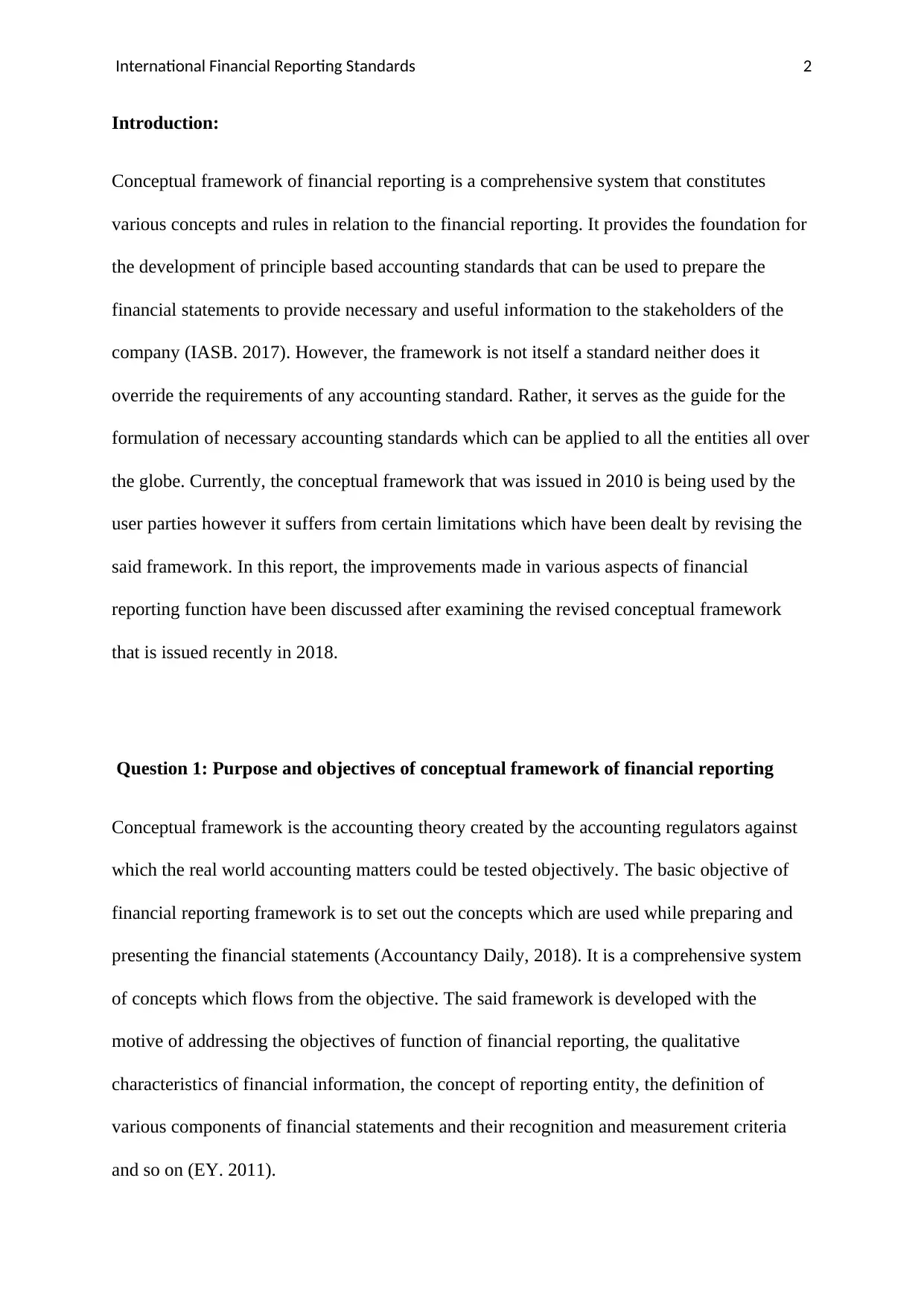
International Financial Reporting Standards 2
Introduction:
Conceptual framework of financial reporting is a comprehensive system that constitutes
various concepts and rules in relation to the financial reporting. It provides the foundation for
the development of principle based accounting standards that can be used to prepare the
financial statements to provide necessary and useful information to the stakeholders of the
company (IASB. 2017). However, the framework is not itself a standard neither does it
override the requirements of any accounting standard. Rather, it serves as the guide for the
formulation of necessary accounting standards which can be applied to all the entities all over
the globe. Currently, the conceptual framework that was issued in 2010 is being used by the
user parties however it suffers from certain limitations which have been dealt by revising the
said framework. In this report, the improvements made in various aspects of financial
reporting function have been discussed after examining the revised conceptual framework
that is issued recently in 2018.
Question 1: Purpose and objectives of conceptual framework of financial reporting
Conceptual framework is the accounting theory created by the accounting regulators against
which the real world accounting matters could be tested objectively. The basic objective of
financial reporting framework is to set out the concepts which are used while preparing and
presenting the financial statements (Accountancy Daily, 2018). It is a comprehensive system
of concepts which flows from the objective. The said framework is developed with the
motive of addressing the objectives of function of financial reporting, the qualitative
characteristics of financial information, the concept of reporting entity, the definition of
various components of financial statements and their recognition and measurement criteria
and so on (EY. 2011).
Introduction:
Conceptual framework of financial reporting is a comprehensive system that constitutes
various concepts and rules in relation to the financial reporting. It provides the foundation for
the development of principle based accounting standards that can be used to prepare the
financial statements to provide necessary and useful information to the stakeholders of the
company (IASB. 2017). However, the framework is not itself a standard neither does it
override the requirements of any accounting standard. Rather, it serves as the guide for the
formulation of necessary accounting standards which can be applied to all the entities all over
the globe. Currently, the conceptual framework that was issued in 2010 is being used by the
user parties however it suffers from certain limitations which have been dealt by revising the
said framework. In this report, the improvements made in various aspects of financial
reporting function have been discussed after examining the revised conceptual framework
that is issued recently in 2018.
Question 1: Purpose and objectives of conceptual framework of financial reporting
Conceptual framework is the accounting theory created by the accounting regulators against
which the real world accounting matters could be tested objectively. The basic objective of
financial reporting framework is to set out the concepts which are used while preparing and
presenting the financial statements (Accountancy Daily, 2018). It is a comprehensive system
of concepts which flows from the objective. The said framework is developed with the
motive of addressing the objectives of function of financial reporting, the qualitative
characteristics of financial information, the concept of reporting entity, the definition of
various components of financial statements and their recognition and measurement criteria
and so on (EY. 2011).
⊘ This is a preview!⊘
Do you want full access?
Subscribe today to unlock all pages.

Trusted by 1+ million students worldwide
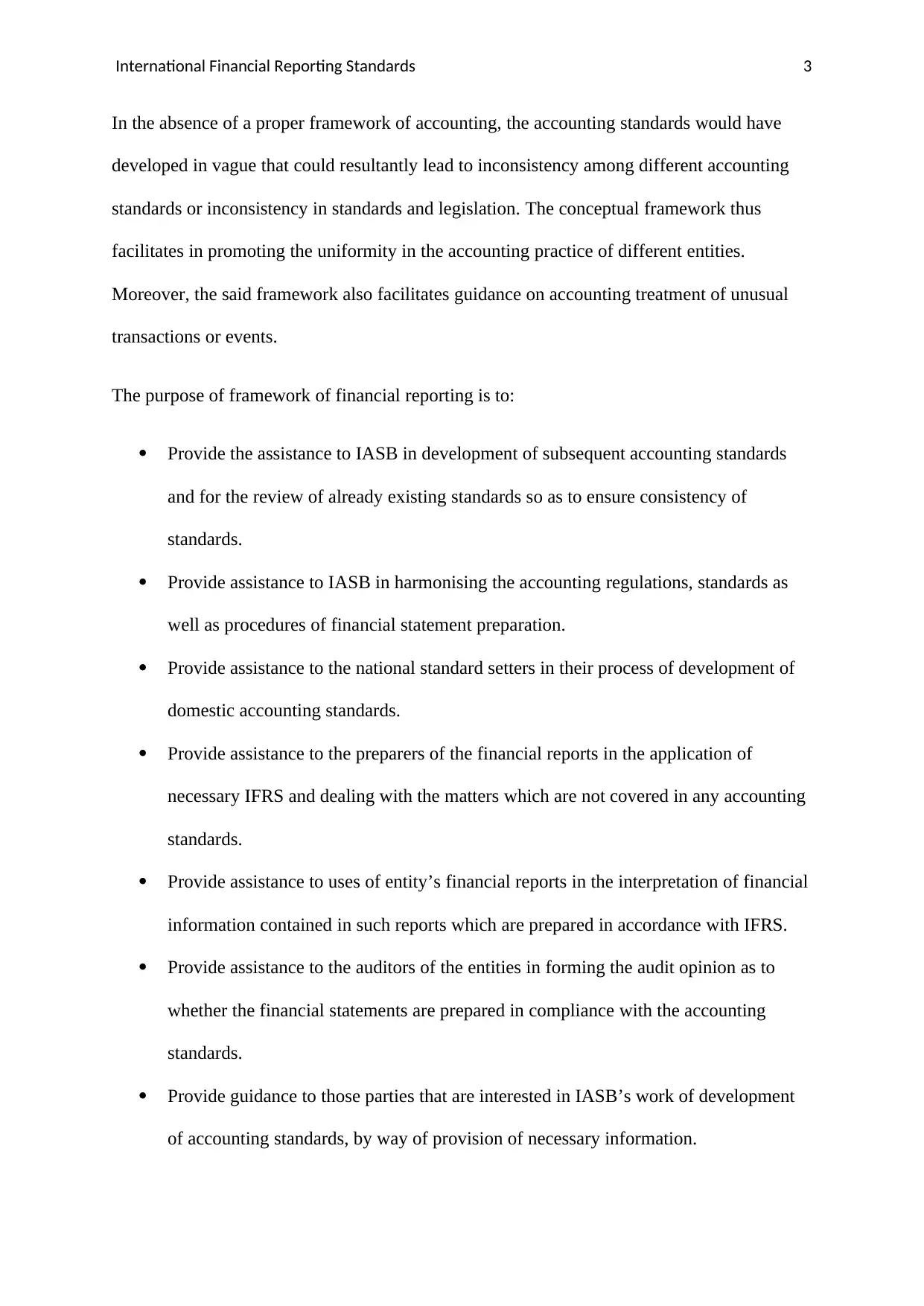
International Financial Reporting Standards 3
In the absence of a proper framework of accounting, the accounting standards would have
developed in vague that could resultantly lead to inconsistency among different accounting
standards or inconsistency in standards and legislation. The conceptual framework thus
facilitates in promoting the uniformity in the accounting practice of different entities.
Moreover, the said framework also facilitates guidance on accounting treatment of unusual
transactions or events.
The purpose of framework of financial reporting is to:
Provide the assistance to IASB in development of subsequent accounting standards
and for the review of already existing standards so as to ensure consistency of
standards.
Provide assistance to IASB in harmonising the accounting regulations, standards as
well as procedures of financial statement preparation.
Provide assistance to the national standard setters in their process of development of
domestic accounting standards.
Provide assistance to the preparers of the financial reports in the application of
necessary IFRS and dealing with the matters which are not covered in any accounting
standards.
Provide assistance to uses of entity’s financial reports in the interpretation of financial
information contained in such reports which are prepared in accordance with IFRS.
Provide assistance to the auditors of the entities in forming the audit opinion as to
whether the financial statements are prepared in compliance with the accounting
standards.
Provide guidance to those parties that are interested in IASB’s work of development
of accounting standards, by way of provision of necessary information.
In the absence of a proper framework of accounting, the accounting standards would have
developed in vague that could resultantly lead to inconsistency among different accounting
standards or inconsistency in standards and legislation. The conceptual framework thus
facilitates in promoting the uniformity in the accounting practice of different entities.
Moreover, the said framework also facilitates guidance on accounting treatment of unusual
transactions or events.
The purpose of framework of financial reporting is to:
Provide the assistance to IASB in development of subsequent accounting standards
and for the review of already existing standards so as to ensure consistency of
standards.
Provide assistance to IASB in harmonising the accounting regulations, standards as
well as procedures of financial statement preparation.
Provide assistance to the national standard setters in their process of development of
domestic accounting standards.
Provide assistance to the preparers of the financial reports in the application of
necessary IFRS and dealing with the matters which are not covered in any accounting
standards.
Provide assistance to uses of entity’s financial reports in the interpretation of financial
information contained in such reports which are prepared in accordance with IFRS.
Provide assistance to the auditors of the entities in forming the audit opinion as to
whether the financial statements are prepared in compliance with the accounting
standards.
Provide guidance to those parties that are interested in IASB’s work of development
of accounting standards, by way of provision of necessary information.
Paraphrase This Document
Need a fresh take? Get an instant paraphrase of this document with our AI Paraphraser
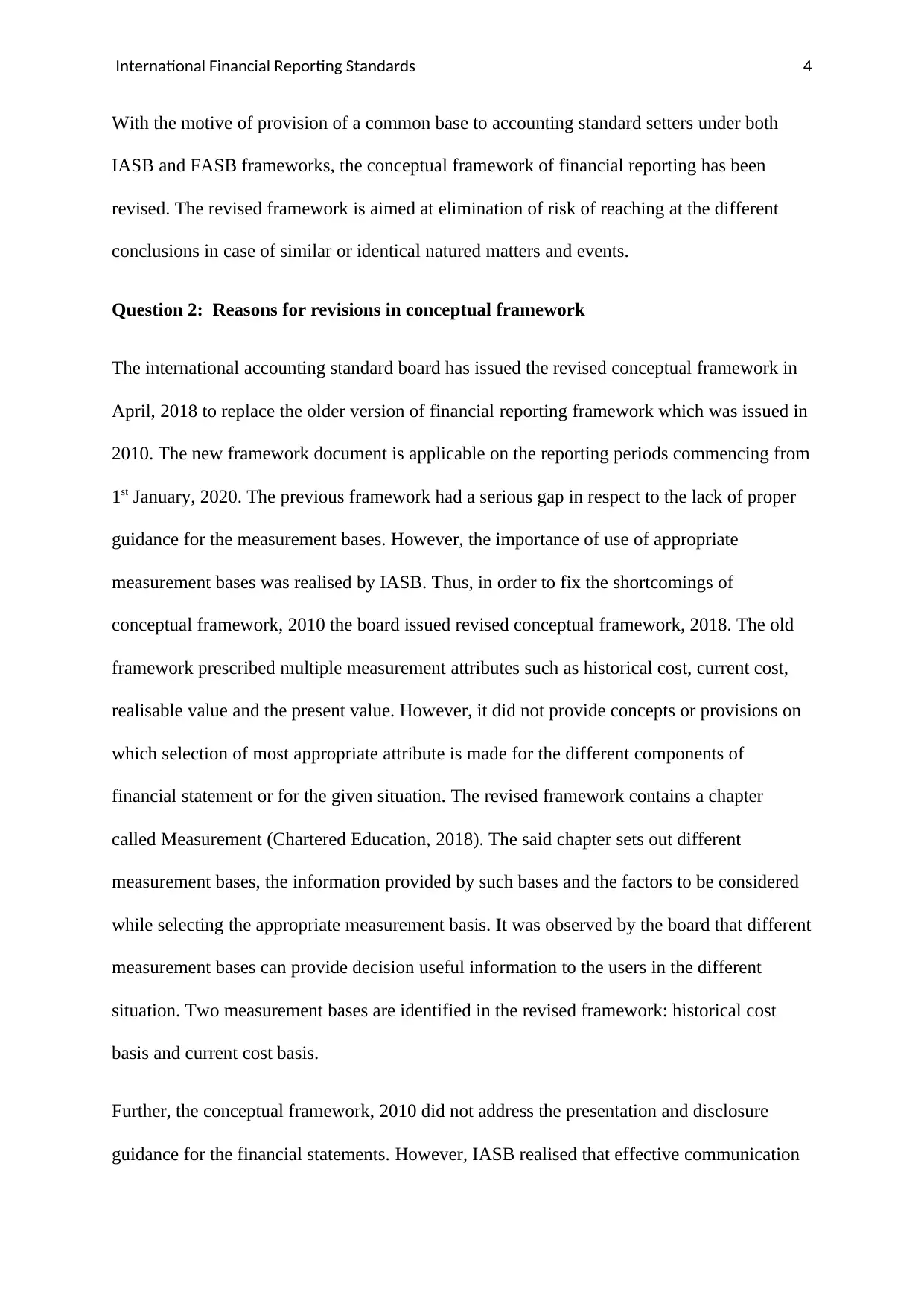
International Financial Reporting Standards 4
With the motive of provision of a common base to accounting standard setters under both
IASB and FASB frameworks, the conceptual framework of financial reporting has been
revised. The revised framework is aimed at elimination of risk of reaching at the different
conclusions in case of similar or identical natured matters and events.
Question 2: Reasons for revisions in conceptual framework
The international accounting standard board has issued the revised conceptual framework in
April, 2018 to replace the older version of financial reporting framework which was issued in
2010. The new framework document is applicable on the reporting periods commencing from
1st January, 2020. The previous framework had a serious gap in respect to the lack of proper
guidance for the measurement bases. However, the importance of use of appropriate
measurement bases was realised by IASB. Thus, in order to fix the shortcomings of
conceptual framework, 2010 the board issued revised conceptual framework, 2018. The old
framework prescribed multiple measurement attributes such as historical cost, current cost,
realisable value and the present value. However, it did not provide concepts or provisions on
which selection of most appropriate attribute is made for the different components of
financial statement or for the given situation. The revised framework contains a chapter
called Measurement (Chartered Education, 2018). The said chapter sets out different
measurement bases, the information provided by such bases and the factors to be considered
while selecting the appropriate measurement basis. It was observed by the board that different
measurement bases can provide decision useful information to the users in the different
situation. Two measurement bases are identified in the revised framework: historical cost
basis and current cost basis.
Further, the conceptual framework, 2010 did not address the presentation and disclosure
guidance for the financial statements. However, IASB realised that effective communication
With the motive of provision of a common base to accounting standard setters under both
IASB and FASB frameworks, the conceptual framework of financial reporting has been
revised. The revised framework is aimed at elimination of risk of reaching at the different
conclusions in case of similar or identical natured matters and events.
Question 2: Reasons for revisions in conceptual framework
The international accounting standard board has issued the revised conceptual framework in
April, 2018 to replace the older version of financial reporting framework which was issued in
2010. The new framework document is applicable on the reporting periods commencing from
1st January, 2020. The previous framework had a serious gap in respect to the lack of proper
guidance for the measurement bases. However, the importance of use of appropriate
measurement bases was realised by IASB. Thus, in order to fix the shortcomings of
conceptual framework, 2010 the board issued revised conceptual framework, 2018. The old
framework prescribed multiple measurement attributes such as historical cost, current cost,
realisable value and the present value. However, it did not provide concepts or provisions on
which selection of most appropriate attribute is made for the different components of
financial statement or for the given situation. The revised framework contains a chapter
called Measurement (Chartered Education, 2018). The said chapter sets out different
measurement bases, the information provided by such bases and the factors to be considered
while selecting the appropriate measurement basis. It was observed by the board that different
measurement bases can provide decision useful information to the users in the different
situation. Two measurement bases are identified in the revised framework: historical cost
basis and current cost basis.
Further, the conceptual framework, 2010 did not address the presentation and disclosure
guidance for the financial statements. However, IASB realised that effective communication
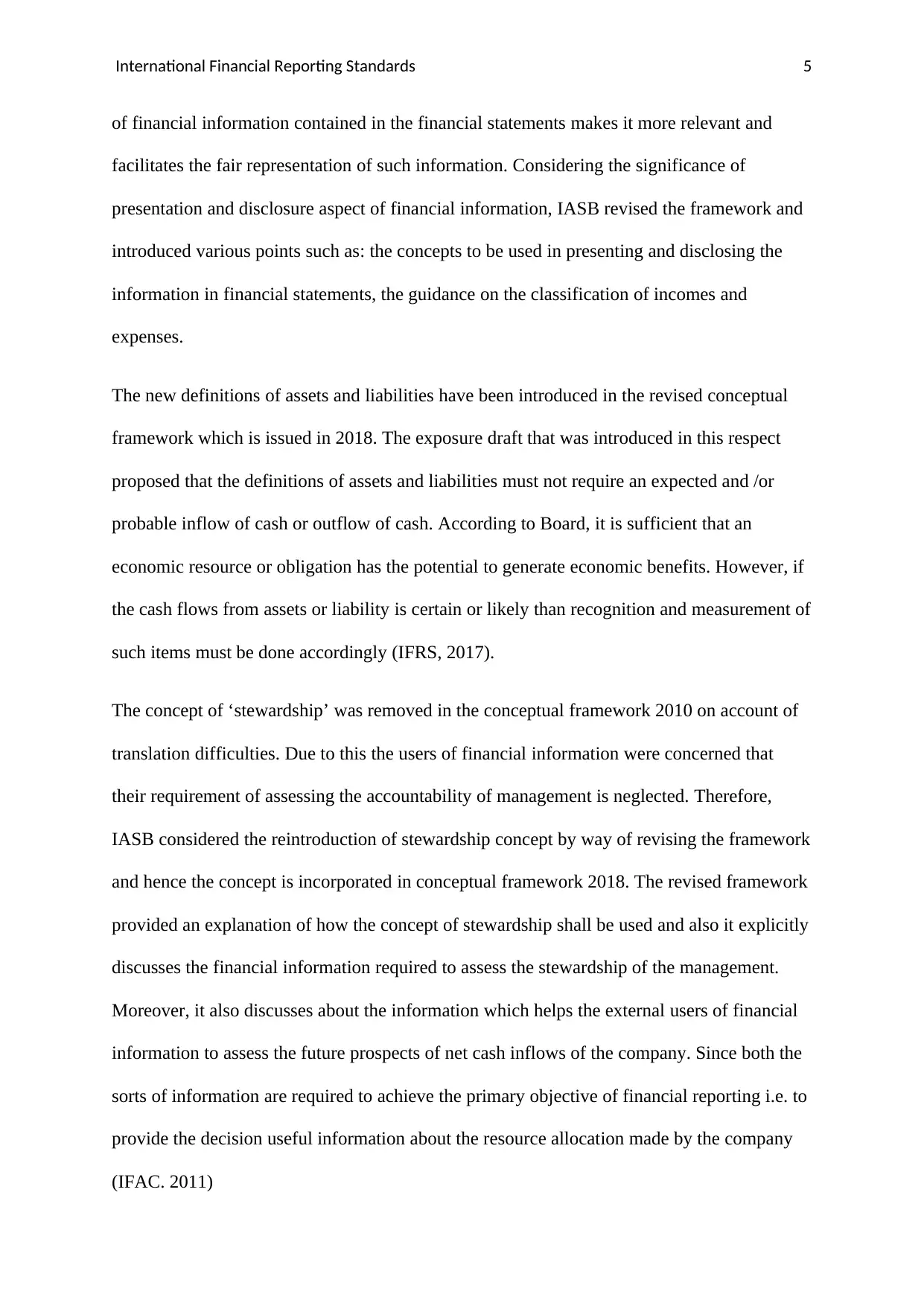
International Financial Reporting Standards 5
of financial information contained in the financial statements makes it more relevant and
facilitates the fair representation of such information. Considering the significance of
presentation and disclosure aspect of financial information, IASB revised the framework and
introduced various points such as: the concepts to be used in presenting and disclosing the
information in financial statements, the guidance on the classification of incomes and
expenses.
The new definitions of assets and liabilities have been introduced in the revised conceptual
framework which is issued in 2018. The exposure draft that was introduced in this respect
proposed that the definitions of assets and liabilities must not require an expected and /or
probable inflow of cash or outflow of cash. According to Board, it is sufficient that an
economic resource or obligation has the potential to generate economic benefits. However, if
the cash flows from assets or liability is certain or likely than recognition and measurement of
such items must be done accordingly (IFRS, 2017).
The concept of ‘stewardship’ was removed in the conceptual framework 2010 on account of
translation difficulties. Due to this the users of financial information were concerned that
their requirement of assessing the accountability of management is neglected. Therefore,
IASB considered the reintroduction of stewardship concept by way of revising the framework
and hence the concept is incorporated in conceptual framework 2018. The revised framework
provided an explanation of how the concept of stewardship shall be used and also it explicitly
discusses the financial information required to assess the stewardship of the management.
Moreover, it also discusses about the information which helps the external users of financial
information to assess the future prospects of net cash inflows of the company. Since both the
sorts of information are required to achieve the primary objective of financial reporting i.e. to
provide the decision useful information about the resource allocation made by the company
(IFAC. 2011)
of financial information contained in the financial statements makes it more relevant and
facilitates the fair representation of such information. Considering the significance of
presentation and disclosure aspect of financial information, IASB revised the framework and
introduced various points such as: the concepts to be used in presenting and disclosing the
information in financial statements, the guidance on the classification of incomes and
expenses.
The new definitions of assets and liabilities have been introduced in the revised conceptual
framework which is issued in 2018. The exposure draft that was introduced in this respect
proposed that the definitions of assets and liabilities must not require an expected and /or
probable inflow of cash or outflow of cash. According to Board, it is sufficient that an
economic resource or obligation has the potential to generate economic benefits. However, if
the cash flows from assets or liability is certain or likely than recognition and measurement of
such items must be done accordingly (IFRS, 2017).
The concept of ‘stewardship’ was removed in the conceptual framework 2010 on account of
translation difficulties. Due to this the users of financial information were concerned that
their requirement of assessing the accountability of management is neglected. Therefore,
IASB considered the reintroduction of stewardship concept by way of revising the framework
and hence the concept is incorporated in conceptual framework 2018. The revised framework
provided an explanation of how the concept of stewardship shall be used and also it explicitly
discusses the financial information required to assess the stewardship of the management.
Moreover, it also discusses about the information which helps the external users of financial
information to assess the future prospects of net cash inflows of the company. Since both the
sorts of information are required to achieve the primary objective of financial reporting i.e. to
provide the decision useful information about the resource allocation made by the company
(IFAC. 2011)
⊘ This is a preview!⊘
Do you want full access?
Subscribe today to unlock all pages.

Trusted by 1+ million students worldwide
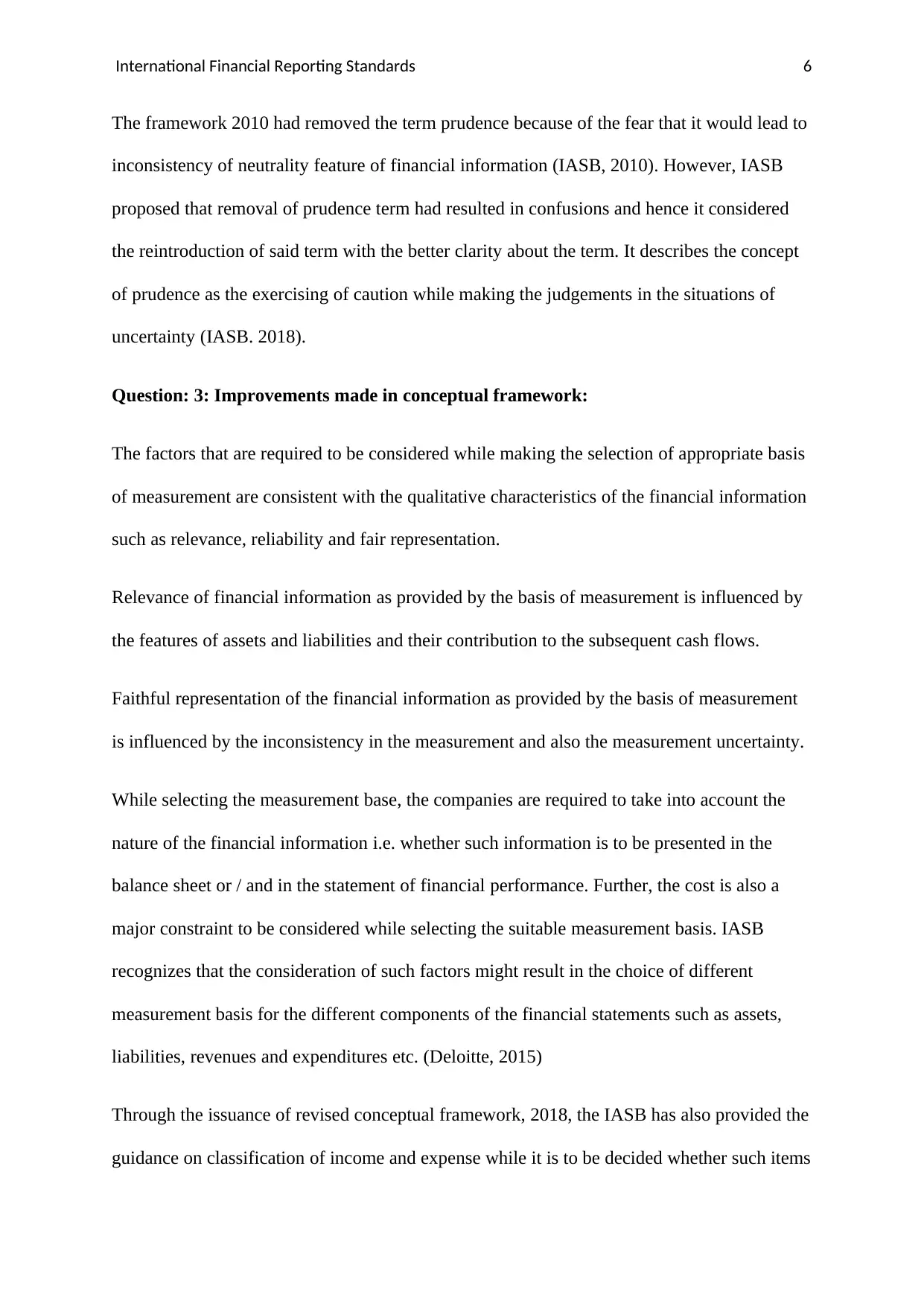
International Financial Reporting Standards 6
The framework 2010 had removed the term prudence because of the fear that it would lead to
inconsistency of neutrality feature of financial information (IASB, 2010). However, IASB
proposed that removal of prudence term had resulted in confusions and hence it considered
the reintroduction of said term with the better clarity about the term. It describes the concept
of prudence as the exercising of caution while making the judgements in the situations of
uncertainty (IASB. 2018).
Question: 3: Improvements made in conceptual framework:
The factors that are required to be considered while making the selection of appropriate basis
of measurement are consistent with the qualitative characteristics of the financial information
such as relevance, reliability and fair representation.
Relevance of financial information as provided by the basis of measurement is influenced by
the features of assets and liabilities and their contribution to the subsequent cash flows.
Faithful representation of the financial information as provided by the basis of measurement
is influenced by the inconsistency in the measurement and also the measurement uncertainty.
While selecting the measurement base, the companies are required to take into account the
nature of the financial information i.e. whether such information is to be presented in the
balance sheet or / and in the statement of financial performance. Further, the cost is also a
major constraint to be considered while selecting the suitable measurement basis. IASB
recognizes that the consideration of such factors might result in the choice of different
measurement basis for the different components of the financial statements such as assets,
liabilities, revenues and expenditures etc. (Deloitte, 2015)
Through the issuance of revised conceptual framework, 2018, the IASB has also provided the
guidance on classification of income and expense while it is to be decided whether such items
The framework 2010 had removed the term prudence because of the fear that it would lead to
inconsistency of neutrality feature of financial information (IASB, 2010). However, IASB
proposed that removal of prudence term had resulted in confusions and hence it considered
the reintroduction of said term with the better clarity about the term. It describes the concept
of prudence as the exercising of caution while making the judgements in the situations of
uncertainty (IASB. 2018).
Question: 3: Improvements made in conceptual framework:
The factors that are required to be considered while making the selection of appropriate basis
of measurement are consistent with the qualitative characteristics of the financial information
such as relevance, reliability and fair representation.
Relevance of financial information as provided by the basis of measurement is influenced by
the features of assets and liabilities and their contribution to the subsequent cash flows.
Faithful representation of the financial information as provided by the basis of measurement
is influenced by the inconsistency in the measurement and also the measurement uncertainty.
While selecting the measurement base, the companies are required to take into account the
nature of the financial information i.e. whether such information is to be presented in the
balance sheet or / and in the statement of financial performance. Further, the cost is also a
major constraint to be considered while selecting the suitable measurement basis. IASB
recognizes that the consideration of such factors might result in the choice of different
measurement basis for the different components of the financial statements such as assets,
liabilities, revenues and expenditures etc. (Deloitte, 2015)
Through the issuance of revised conceptual framework, 2018, the IASB has also provided the
guidance on classification of income and expense while it is to be decided whether such items
Paraphrase This Document
Need a fresh take? Get an instant paraphrase of this document with our AI Paraphraser
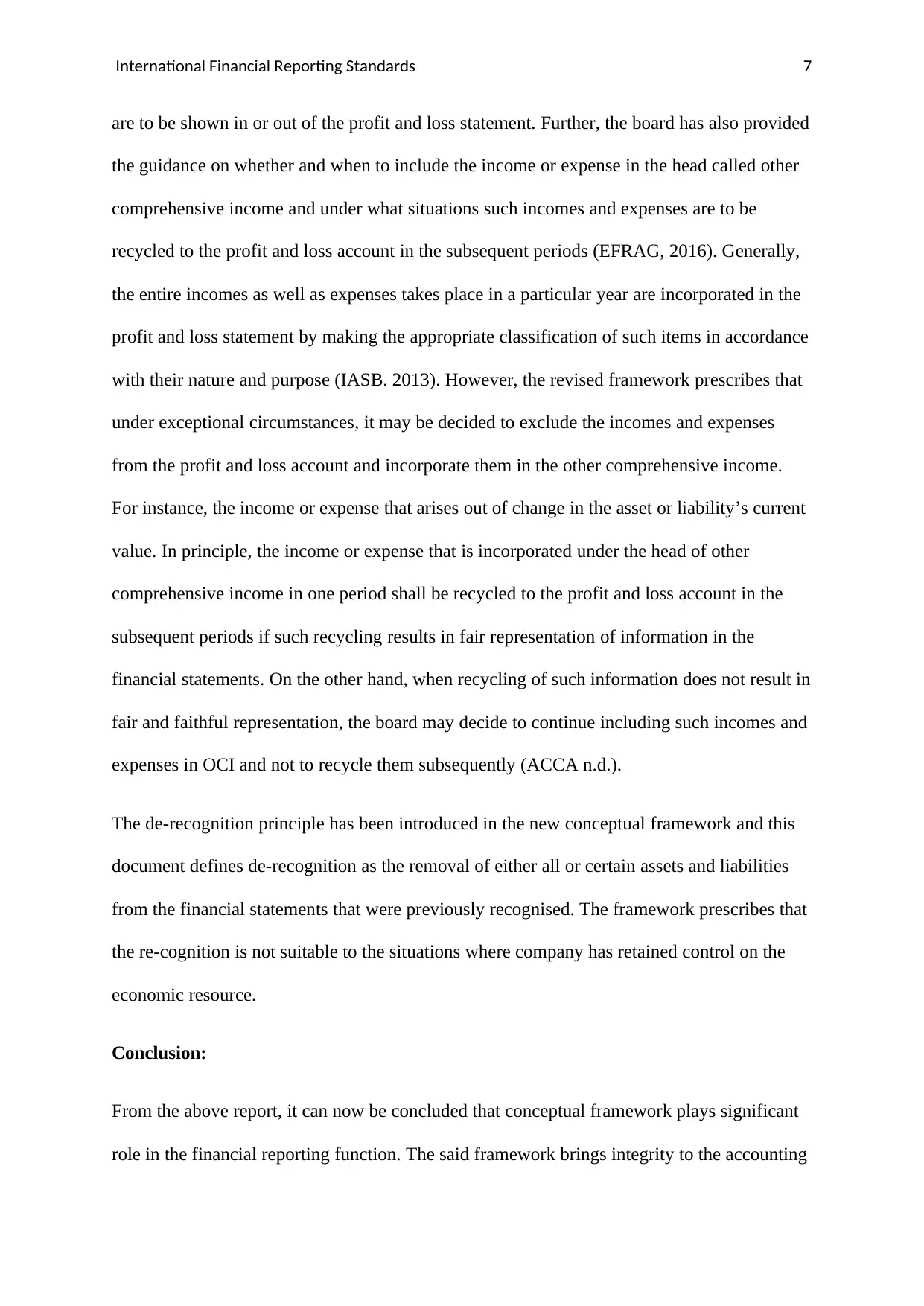
International Financial Reporting Standards 7
are to be shown in or out of the profit and loss statement. Further, the board has also provided
the guidance on whether and when to include the income or expense in the head called other
comprehensive income and under what situations such incomes and expenses are to be
recycled to the profit and loss account in the subsequent periods (EFRAG, 2016). Generally,
the entire incomes as well as expenses takes place in a particular year are incorporated in the
profit and loss statement by making the appropriate classification of such items in accordance
with their nature and purpose (IASB. 2013). However, the revised framework prescribes that
under exceptional circumstances, it may be decided to exclude the incomes and expenses
from the profit and loss account and incorporate them in the other comprehensive income.
For instance, the income or expense that arises out of change in the asset or liability’s current
value. In principle, the income or expense that is incorporated under the head of other
comprehensive income in one period shall be recycled to the profit and loss account in the
subsequent periods if such recycling results in fair representation of information in the
financial statements. On the other hand, when recycling of such information does not result in
fair and faithful representation, the board may decide to continue including such incomes and
expenses in OCI and not to recycle them subsequently (ACCA n.d.).
The de-recognition principle has been introduced in the new conceptual framework and this
document defines de-recognition as the removal of either all or certain assets and liabilities
from the financial statements that were previously recognised. The framework prescribes that
the re-cognition is not suitable to the situations where company has retained control on the
economic resource.
Conclusion:
From the above report, it can now be concluded that conceptual framework plays significant
role in the financial reporting function. The said framework brings integrity to the accounting
are to be shown in or out of the profit and loss statement. Further, the board has also provided
the guidance on whether and when to include the income or expense in the head called other
comprehensive income and under what situations such incomes and expenses are to be
recycled to the profit and loss account in the subsequent periods (EFRAG, 2016). Generally,
the entire incomes as well as expenses takes place in a particular year are incorporated in the
profit and loss statement by making the appropriate classification of such items in accordance
with their nature and purpose (IASB. 2013). However, the revised framework prescribes that
under exceptional circumstances, it may be decided to exclude the incomes and expenses
from the profit and loss account and incorporate them in the other comprehensive income.
For instance, the income or expense that arises out of change in the asset or liability’s current
value. In principle, the income or expense that is incorporated under the head of other
comprehensive income in one period shall be recycled to the profit and loss account in the
subsequent periods if such recycling results in fair representation of information in the
financial statements. On the other hand, when recycling of such information does not result in
fair and faithful representation, the board may decide to continue including such incomes and
expenses in OCI and not to recycle them subsequently (ACCA n.d.).
The de-recognition principle has been introduced in the new conceptual framework and this
document defines de-recognition as the removal of either all or certain assets and liabilities
from the financial statements that were previously recognised. The framework prescribes that
the re-cognition is not suitable to the situations where company has retained control on the
economic resource.
Conclusion:
From the above report, it can now be concluded that conceptual framework plays significant
role in the financial reporting function. The said framework brings integrity to the accounting
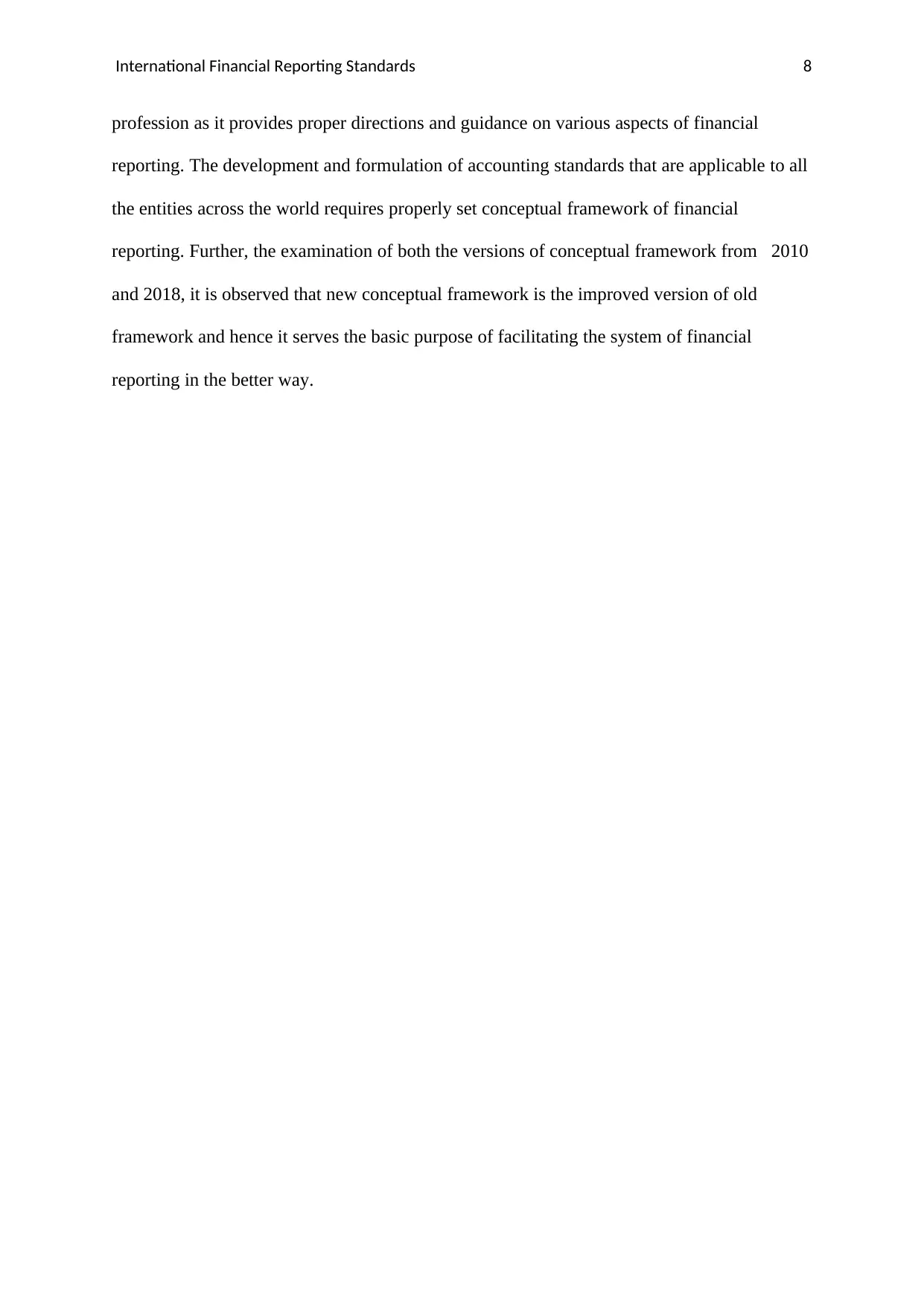
International Financial Reporting Standards 8
profession as it provides proper directions and guidance on various aspects of financial
reporting. The development and formulation of accounting standards that are applicable to all
the entities across the world requires properly set conceptual framework of financial
reporting. Further, the examination of both the versions of conceptual framework from 2010
and 2018, it is observed that new conceptual framework is the improved version of old
framework and hence it serves the basic purpose of facilitating the system of financial
reporting in the better way.
profession as it provides proper directions and guidance on various aspects of financial
reporting. The development and formulation of accounting standards that are applicable to all
the entities across the world requires properly set conceptual framework of financial
reporting. Further, the examination of both the versions of conceptual framework from 2010
and 2018, it is observed that new conceptual framework is the improved version of old
framework and hence it serves the basic purpose of facilitating the system of financial
reporting in the better way.
⊘ This is a preview!⊘
Do you want full access?
Subscribe today to unlock all pages.

Trusted by 1+ million students worldwide
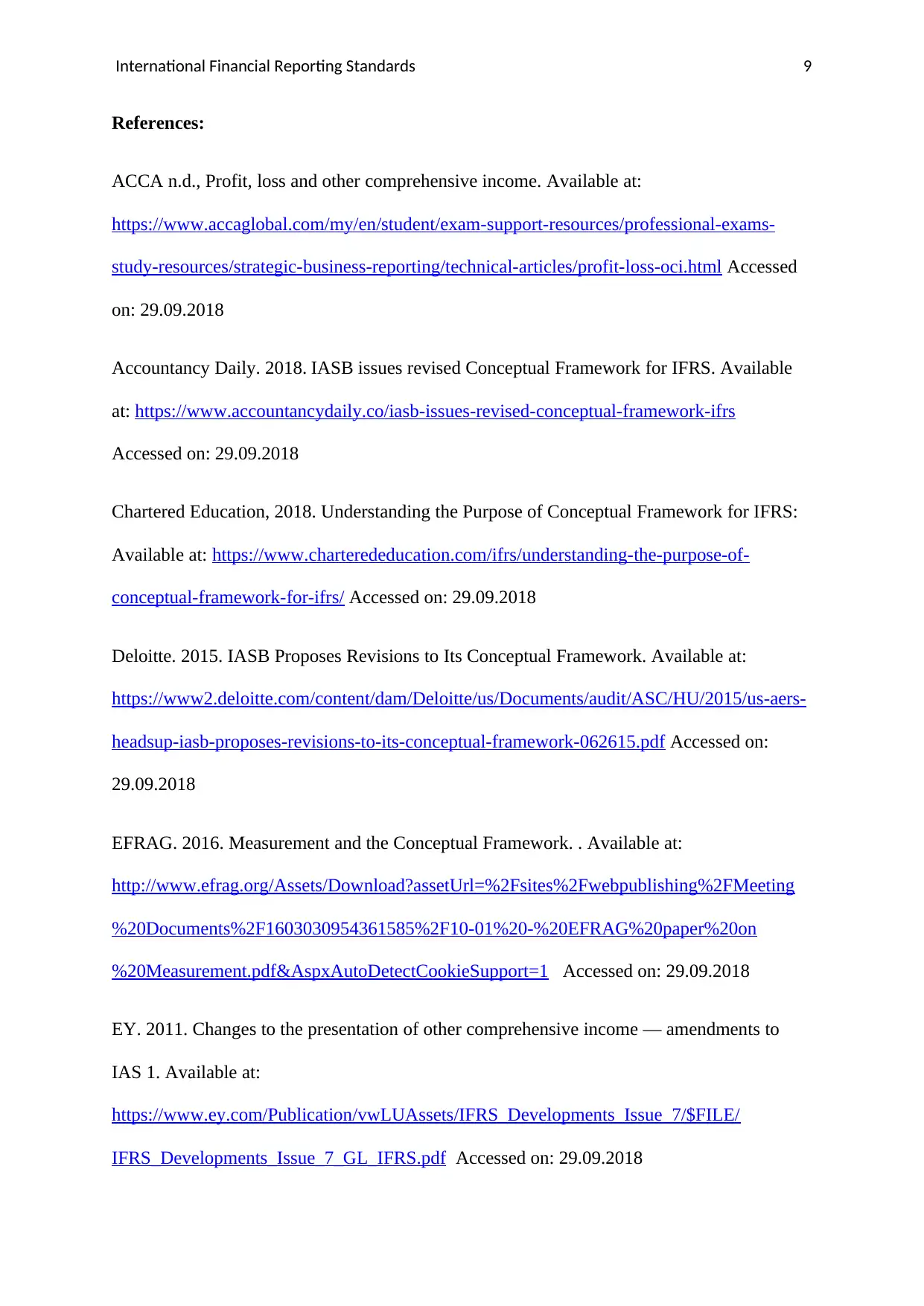
International Financial Reporting Standards 9
References:
ACCA n.d., Profit, loss and other comprehensive income. Available at:
https://www.accaglobal.com/my/en/student/exam-support-resources/professional-exams-
study-resources/strategic-business-reporting/technical-articles/profit-loss-oci.html Accessed
on: 29.09.2018
Accountancy Daily. 2018. IASB issues revised Conceptual Framework for IFRS. Available
at: https://www.accountancydaily.co/iasb-issues-revised-conceptual-framework-ifrs
Accessed on: 29.09.2018
Chartered Education, 2018. Understanding the Purpose of Conceptual Framework for IFRS:
Available at: https://www.charterededucation.com/ifrs/understanding-the-purpose-of-
conceptual-framework-for-ifrs/ Accessed on: 29.09.2018
Deloitte. 2015. IASB Proposes Revisions to Its Conceptual Framework. Available at:
https://www2.deloitte.com/content/dam/Deloitte/us/Documents/audit/ASC/HU/2015/us-aers-
headsup-iasb-proposes-revisions-to-its-conceptual-framework-062615.pdf Accessed on:
29.09.2018
EFRAG. 2016. Measurement and the Conceptual Framework. . Available at:
http://www.efrag.org/Assets/Download?assetUrl=%2Fsites%2Fwebpublishing%2FMeeting
%20Documents%2F1603030954361585%2F10-01%20-%20EFRAG%20paper%20on
%20Measurement.pdf&AspxAutoDetectCookieSupport=1 Accessed on: 29.09.2018
EY. 2011. Changes to the presentation of other comprehensive income — amendments to
IAS 1. Available at:
https://www.ey.com/Publication/vwLUAssets/IFRS_Developments_Issue_7/$FILE/
IFRS_Developments_Issue_7_GL_IFRS.pdf Accessed on: 29.09.2018
References:
ACCA n.d., Profit, loss and other comprehensive income. Available at:
https://www.accaglobal.com/my/en/student/exam-support-resources/professional-exams-
study-resources/strategic-business-reporting/technical-articles/profit-loss-oci.html Accessed
on: 29.09.2018
Accountancy Daily. 2018. IASB issues revised Conceptual Framework for IFRS. Available
at: https://www.accountancydaily.co/iasb-issues-revised-conceptual-framework-ifrs
Accessed on: 29.09.2018
Chartered Education, 2018. Understanding the Purpose of Conceptual Framework for IFRS:
Available at: https://www.charterededucation.com/ifrs/understanding-the-purpose-of-
conceptual-framework-for-ifrs/ Accessed on: 29.09.2018
Deloitte. 2015. IASB Proposes Revisions to Its Conceptual Framework. Available at:
https://www2.deloitte.com/content/dam/Deloitte/us/Documents/audit/ASC/HU/2015/us-aers-
headsup-iasb-proposes-revisions-to-its-conceptual-framework-062615.pdf Accessed on:
29.09.2018
EFRAG. 2016. Measurement and the Conceptual Framework. . Available at:
http://www.efrag.org/Assets/Download?assetUrl=%2Fsites%2Fwebpublishing%2FMeeting
%20Documents%2F1603030954361585%2F10-01%20-%20EFRAG%20paper%20on
%20Measurement.pdf&AspxAutoDetectCookieSupport=1 Accessed on: 29.09.2018
EY. 2011. Changes to the presentation of other comprehensive income — amendments to
IAS 1. Available at:
https://www.ey.com/Publication/vwLUAssets/IFRS_Developments_Issue_7/$FILE/
IFRS_Developments_Issue_7_GL_IFRS.pdf Accessed on: 29.09.2018
Paraphrase This Document
Need a fresh take? Get an instant paraphrase of this document with our AI Paraphraser
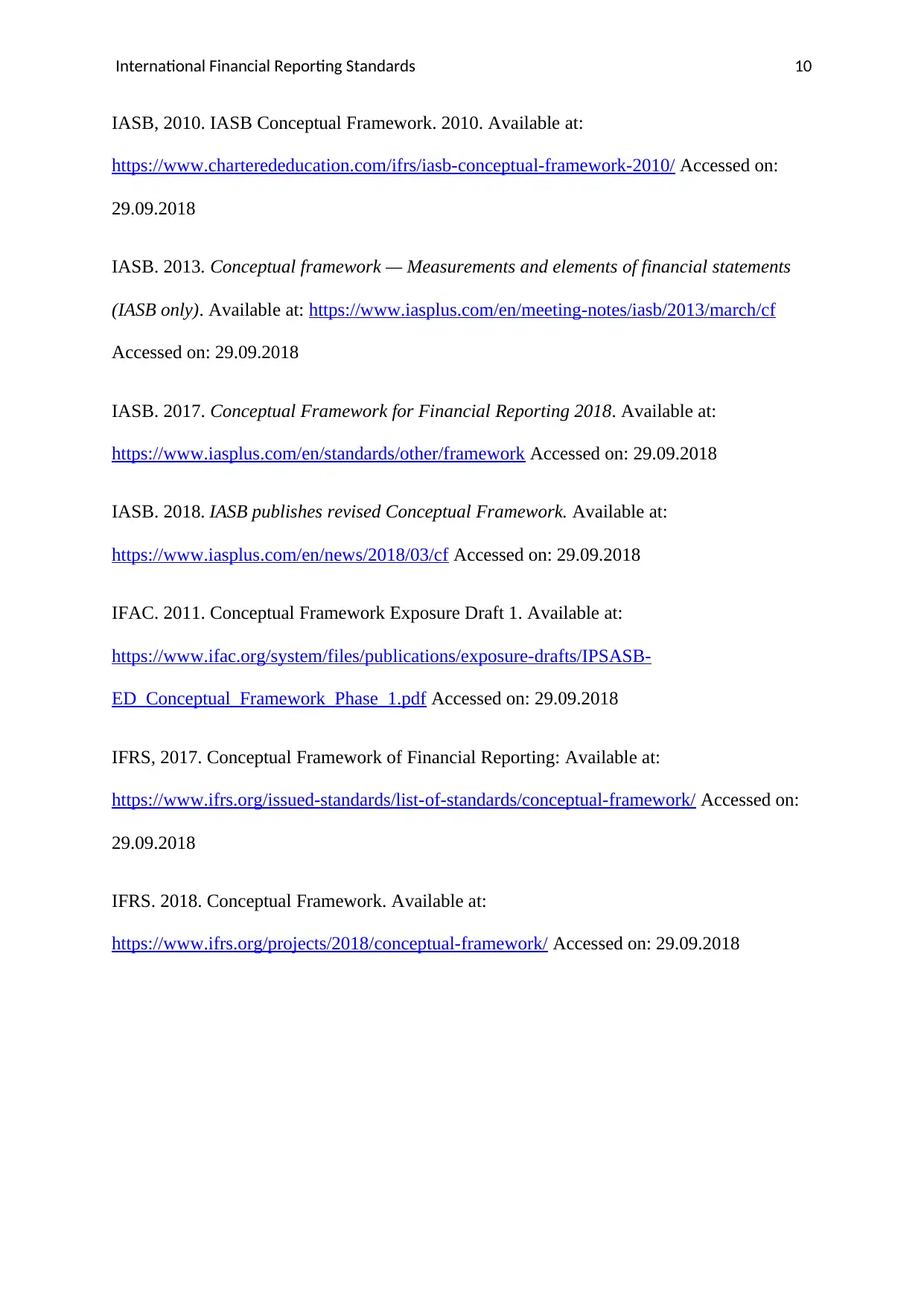
International Financial Reporting Standards 10
IASB, 2010. IASB Conceptual Framework. 2010. Available at:
https://www.charterededucation.com/ifrs/iasb-conceptual-framework-2010/ Accessed on:
29.09.2018
IASB. 2013. Conceptual framework — Measurements and elements of financial statements
(IASB only). Available at: https://www.iasplus.com/en/meeting-notes/iasb/2013/march/cf
Accessed on: 29.09.2018
IASB. 2017. Conceptual Framework for Financial Reporting 2018. Available at:
https://www.iasplus.com/en/standards/other/framework Accessed on: 29.09.2018
IASB. 2018. IASB publishes revised Conceptual Framework. Available at:
https://www.iasplus.com/en/news/2018/03/cf Accessed on: 29.09.2018
IFAC. 2011. Conceptual Framework Exposure Draft 1. Available at:
https://www.ifac.org/system/files/publications/exposure-drafts/IPSASB-
ED_Conceptual_Framework_Phase_1.pdf Accessed on: 29.09.2018
IFRS, 2017. Conceptual Framework of Financial Reporting: Available at:
https://www.ifrs.org/issued-standards/list-of-standards/conceptual-framework/ Accessed on:
29.09.2018
IFRS. 2018. Conceptual Framework. Available at:
https://www.ifrs.org/projects/2018/conceptual-framework/ Accessed on: 29.09.2018
IASB, 2010. IASB Conceptual Framework. 2010. Available at:
https://www.charterededucation.com/ifrs/iasb-conceptual-framework-2010/ Accessed on:
29.09.2018
IASB. 2013. Conceptual framework — Measurements and elements of financial statements
(IASB only). Available at: https://www.iasplus.com/en/meeting-notes/iasb/2013/march/cf
Accessed on: 29.09.2018
IASB. 2017. Conceptual Framework for Financial Reporting 2018. Available at:
https://www.iasplus.com/en/standards/other/framework Accessed on: 29.09.2018
IASB. 2018. IASB publishes revised Conceptual Framework. Available at:
https://www.iasplus.com/en/news/2018/03/cf Accessed on: 29.09.2018
IFAC. 2011. Conceptual Framework Exposure Draft 1. Available at:
https://www.ifac.org/system/files/publications/exposure-drafts/IPSASB-
ED_Conceptual_Framework_Phase_1.pdf Accessed on: 29.09.2018
IFRS, 2017. Conceptual Framework of Financial Reporting: Available at:
https://www.ifrs.org/issued-standards/list-of-standards/conceptual-framework/ Accessed on:
29.09.2018
IFRS. 2018. Conceptual Framework. Available at:
https://www.ifrs.org/projects/2018/conceptual-framework/ Accessed on: 29.09.2018
1 out of 11
Related Documents
Your All-in-One AI-Powered Toolkit for Academic Success.
+13062052269
info@desklib.com
Available 24*7 on WhatsApp / Email
![[object Object]](/_next/static/media/star-bottom.7253800d.svg)
Unlock your academic potential
Copyright © 2020–2026 A2Z Services. All Rights Reserved. Developed and managed by ZUCOL.





